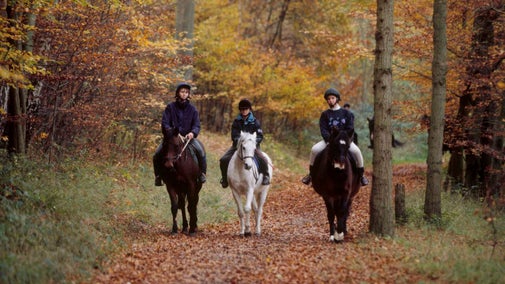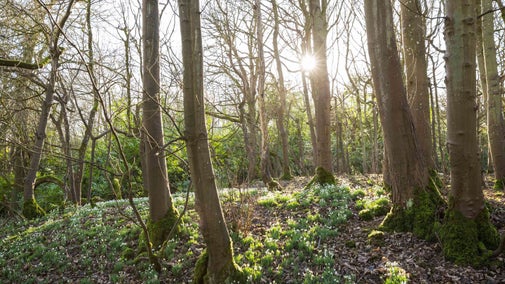
Discover more at Ashridge Estate
Find out when Ashridge Estate is open, how to get here, the things to see and do and more.

The estate consists of 5,000 acres of woodland, parkland and chalk downlands. Walk from Pitstone to Ivinghoe Beacon across chalk grasslands, explore Pitstone Windmill, or visit Bridgewater Monument at the centre of the estate.
With the drier, hotter summers we are experiencing, the risk of serious fire at Ashridge Estate increases. In order to protect the ancient woodland and its wildlife, BBQs are no longer permitted anywhere on the estate. If you are bringing a picnic please remember to take all rubbish home with you. Litter left in the landscape not only presents a danger to wildlife but also creates a fire risk particularly during hot weather. Thank you for your cooperation and for helping to care for this special place.
On the approach to Ashridge visitor centre, you can’t miss this towering granite column which reaches high above the treetops of the estate.
The monument was built in 1832 in memory of the 3rd Duke of Bridgewater, Francis Egerton, who once lived in Ashridge house. As you walk around its York stone base, notice how the monument is dedicated to 'the father of inland navigation' because the duke became famous for building canals during the Industrial Revolution.
During weekends from April to October and when the weather is good, the monument is open and you can take on the challenge of climbing all 172 steps to the top. As you scale the winding steps, take time to feel the rough cold blocks of granite and peek through the windows as you leave the ground behind. £2.50 per adult and £1.50 per child. Free for National Trust members.
When you reach the top, you’ll be rewarded with panoramic views of Ashridge Estate and rolling Chiltern’s countryside. In fine weather, you may be able to see Canary Wharf in central London, over 30 miles away.
Although Ivinghoe Beacon is not the highest point on the Ashridge Estate, it has spectacular views of the surrounding countryside.
There has been human activity on this site since the Bronze Age. You may be able to make out the outline of the remains of an Iron Age hillfort on top of the beacon. Bronze Age burial mounds can be seen throughout the area – all are Scheduled Ancient Monuments.
Our ancestors farmed this landscape for centuries and the cattle and sheep you see here today are a continuation of that process. The animals create the right conditions for wildflowers and butterflies to thrive.
Further south towards Incombe Hole you can see the work of our ancestors at the prehistoric earthwork, Grim's Ditch. The Beacon is the end of the Ridgeway National Trail which starts at Overton Hill on the Marlborough Downs, Wiltshire. It is also the start of the Icknield Way Trail than runs 110 miles to Knettishall Heath on the Norfolk/Suffolk border.
Approaching Pitstone post mill from the surrounding Chiltern countryside gives you magical views which change with the seasons, making it worth a visit even when the mill is closed.
Pitstone Windmill is an early post mill so, unlike similar mills in East Anglia, it was turned to face the wind on top of a huge wooden post using a tail pole instead of a fantail or shuttered sails.
The earliest date found inscribed in the woodwork is 1627, although it’s generally thought it was built earlier. The mill served its community for three centuries until a freak storm in 1902 caused extensive damage.
Although it’s no longer in use today, its machinery, including the windshaft and the brake wheel, is still intact and was restored by the Pitstone Windmill Restoration Committee, a team of volunteers set up in 1963 to rescue the mill.
Gravity combined with two types of stone (coarse Peak Stones and French Burr), to mill wheat into both animal feed and flour.
The mill would have been powered by common sails, consisting of a simple framework covered with a sail cloth which could be reefed and furled by hand according to the strength of the wind. The mill is turned to face the wind by means of a tail pole running on a single cartwheel.
The sails rotate the windshaft, which was a moving set of gear wheels attached to the mill stones. As the wheels grind the grain, it falls through to the floor below to be bagged as wholemeal flour or separated into grades of white flour and bran.

Two major habitats found at Ashridge are the woodlands in the south of the Estate and the chalk grassland and scrub found on the hills to the north. These provide a home for the vast number of creatures that live at Ashridge.
There are good numbers of nuthatches, tree creepers and tawny owls as well as the smaller species such as goldcrest in the conifer plantations. If you are lucky you may see a lesser-spotted woodpecker or a firecrest.
A very rare butterfly is found near the Ivinghoe Beacon during spring – the Duke of Burgundy is one of Britain’s fastest declining butterflies, but it has a strong population here at Ashridge.
The fallow deer rut takes place around October when the woods resound to the noise of bucks trying to attract mates. Deer come from all over the Estate to gather on the traditional rutting stands where the males stake out their display areas by ‘groaning’ and scent marking. After about a month when the action is over, they disperse again.
Autumn is a beautiful time to enjoy the woods as leaves turn vibrant shades and fungi add splashes of colour across the forest floor. However, as Ashridge is a Site of Special Scientific Interest (SSSI), foraging isn’t permitted anywhere on the estate.
Instead, the season can be enjoyed through drawing or photography, using apps or guides to help identify what you see while leaving nature undisturbed. By leaving fungi where they grow, you’ll be helping to protect the delicate ecosystem so that wildlife and visitors can continue to enjoy it.

Find out when Ashridge Estate is open, how to get here, the things to see and do and more.
Ashridge has over 80 miles of pathways to explore, on foot, on bike and on horseback.

Ashridge's long history begins with Iron Age farms, Roman settlements and a royal park, to Lancelot ‘Capability’ Brown creating the Golden Valley.

The fallow deer are an integral part of the landscape at Ashridge and a much-loved feature of this historic estate. Find out about their history here and how we manage them.

Ashridge is a two pawprint rated place with over 80 miles of pathways. Find out more here.

Discover the volunteering roles currently available at Ashridge Estate, and how you can apply and get involved today.

Plan a visit to one of the special countryside places in our care and discover the benefits of being in the great outdoors. Pack your walking boots and get ready to explore woodlands, valleys and rivers.

Explore some of the finest landscapes in our care on coastal paths, accessible trails, woodland walks and everything in between. Find the best places to walk near you.

Explore an ancient forest, acres of chalk grassland and other hidden countryside spaces around Essex, Bedfordshire and Hertfordshire.
